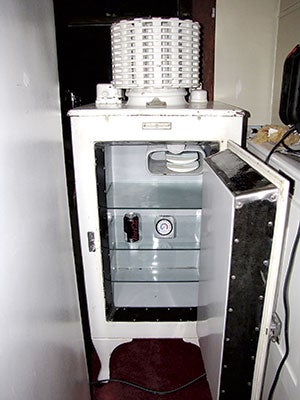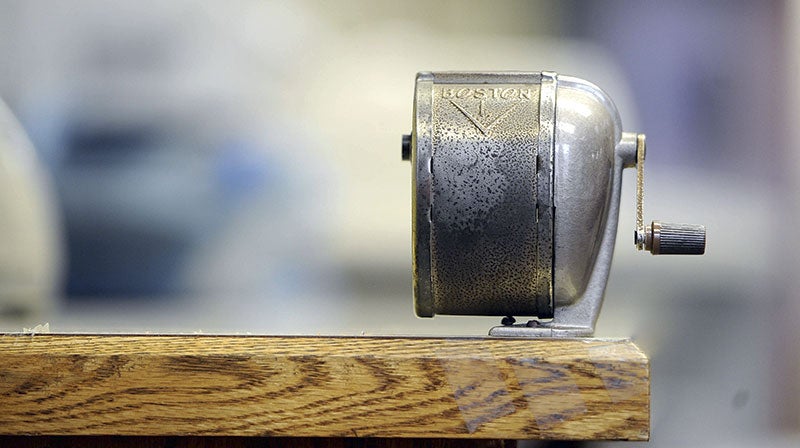Full Circle: Early refrigerators came with plenty of work
Published 10:27 am Friday, October 2, 2015
Your refrigerator! What a reliable, even friendly helpmate it is. But this was not always so. Do you remember ice boxes? If today’s child asked what that was, you’d tell him it was just that; a box standing on end with ice in it — along with a couple of shelves, a door and a handle to access those shelves. “But, didn’t the ice melt?” the child would question? Well, yes it did, and therein lay the problem.
Blocks of ice, you’d explain, had to be cut out of the East Side Lake and delivered to your house in a horse drawn wagon. “Wow,” that same child would sigh, “sure sounds like a lot of work!” And that child would be right. It was! Still, it was a whole lot better than running down to the root cellar (or, like us in Minnesota, to the snowdrift outside the kitchen door) every time the housewife wanted something.
The ice box, being a bit on the suboptimal side, was precisely why in the ‘20s, Kelvinator came up with a wooden cold box/compressor combo. It cost $714, the equivalent of $9,800 in today’s market! As you can imagine, it was unaffordable. So in stepped General Electric, who poured $18 million into research over the next 14 years in which time they made 4,000 models of 19 different types before finally putting one of them on the market. And when they did, Austin women rejoiced for it meant no longer cleaning up puddles of melted lake ice from their kitchen floors.
G.E.’s new and improved model was called a Monitor-top. Do you know why? Because the cylindrical compressor on top looked like the turret from the 19th Century warship, the USS Monitor. Now you know. And it wasn’t even Paul Harvey who told you.
The Monitor-top was a true marvel. Even so it was hard convincing the housewives of this. After all, the refrigerator had only one requirement, plugging it into the wall — that is if the kitchen had an outlet — and how could anyone trust something as uncomplicated as that? Furthermore, the Monitor-top didn’t contain a single belt, drain, fan or stuff box, whatever that was, and wonder of wonders, it never required oiling! Could those women truly believe life could be that simple?
I remember Mom having to clean the coils that encircled her condenser for it attracted dust like flies on a ham sandwich. It was a pesky job requiring a step stool, a bendable back and long arms. G.E. must have heard her complaining for later they even improved on that by concocting a condenser which blew out the dust instead of drawing it in. In 1927, this sensation sold for an (almost) affordable $300. Truly G.E. was a company with a heart.
When I married in 1958, our first apartment came with its own refrigerator. It stood only four feet tall and our tiny kitchen sink (about the size of a medium frying pan), was built into the top. Talk about minimalism! But then, what could one do with a kitchen so small only one person could fit into it at a time? My husband and I had to take turns. I’ve never heard of another refrigerator like this and I’m thinking that is probably a good thing.
My next refrigerator was in our second apartment. It was larger than the previous refrigerator/sink combo and I would describe it as being a mighty beast. It alone produced enough ice to satisfy the needs of the city. Each morning when I opened the door, the thick hoarfrost around the dinky freezer looked like a band of Inuits had built an igloo while I slept. Like they were attempting to reenact the Ice Age all over again! And it mattered not a whit how diligent I was, for I could never ever get ahead of its ferocious frosty build-up.
Defrosting required one of two things, both of which necessitated the use of all our bath towels, because once the melting began it turned into a spring thaw.
1. Stuff the towels around the contents of the refrigerator, unplug it with the door closed and allow hours of cooling to ever so slowly melt the iceberg by itself.
2. Leave the door open so the heat from the room could melt the ice. With this tactic you soon noticed that what began as slow drips soon turned into a flood which quickly swamped the contents below (the towels unable to absorb the deluge), and then spilled out the door and onto the floor, turning me right back into that 1920s ice box housewife who mopped up the danged puddles from her linoleum!
Now, if defrosting was a rush job, I had the choice of using a hammer and chisel, a screwdriver, or in the case of a more serious icy build-up, a crowbar. Either weapon resulted in a perilous exercise. As I chopped and hacked away, I could feel my ladylike self turn into a feral she-devil, my blood coursing through the arm that held the weapon. To be sure, my face folded into a crease of consternation and my thoughts turned to four letter words.
On a good day, however, when only a small chisel was required, there were just the requisite two ice cube trays to contend with. The metal trays had a handle on top whose purpose was to release the cubes. This never, I repeat never, worked! First you had to run the trays under hot water to loosen the cubes that resisted as if they’d been mixed with Elmer’s Glue. This clever trick, albeit, defeated the entire purpose of making ice cubes in the first place for the cubes melted (dah!) under the stream of the hot water!
If, on the other hand, Lady Luck was smiling on you, allowing you to release the cubes without the hot water, your good fortune soon ran out for only those in the center of the tray came out whole, the hold-outs at the shallow end splintering into shards of flying ice that melted all over the kitchen floor which again required bringing out the mop. This was particularly troubling when you had company for dinner and you were trying your best, despite the ice chips in your hair, to put on a calm domestic front.
Then one day I had a defrosting epiphany. Like a clarion call it came to me. Silly, girl, don’t you know there’s a much faster way to dissolve this nightmare? Cast out the crowbar. Use your hair dryer! With this insightful wisdom, I once again laid our entire supply of towels over the shelves and floor, praising myself for both my cleverness and my thoroughness. Then in a defrosting fervor, as if I alone were freeing Shackleton and his crew from their frozen yearlong prison, I flipped the switch on the hair dryer. I could see the Daily Herald headlines now: Local Housewife Frees Explorers!
Immediately, like a Popsicle on a July day, the compacted ice began to dissolve. I could barely contain my joy. That’s when the phone rang. Not wanting to stop my progress, I flailed about for another idea (I was just full of them!). Let’s see … if I left the hair dryer running and lay it on the top shelf, angling it precisely towards the igloo, it would continue to work while I chatted on the phone, right? Well, wouldn’t it?
It did. Did so well, in fact, that its heated rays melted not only the ice, but also the plastic shelves in the door. Criminy! Fortunately for me, our refrigerator continued to work, the sound of its motor humming away, reminding me of a contented cow after chewing a particularly delicious cud. From that day on, though, its wavy walls and curled edges would always be a reminder of my folly, even though I still thought my hair dryer idea was a good one. I just needed to tell my friends to hold off on their calls.
Peggy Keener of Austin is the author of “Potato In A Rice Bowl,” which outlines her experiences living in Japan in the 1960s while her husband was in the military. Peggy Keener invites readers to share their memories with her by emailing pggyknr@yahoo.com. Memories shared with Keener may be shared or referenced in subsequent editions of “Full Circle.”



